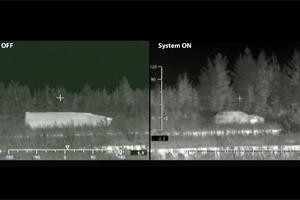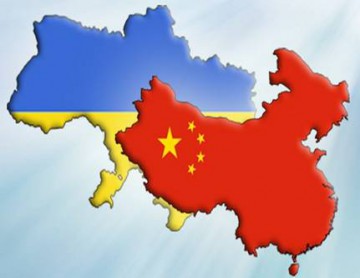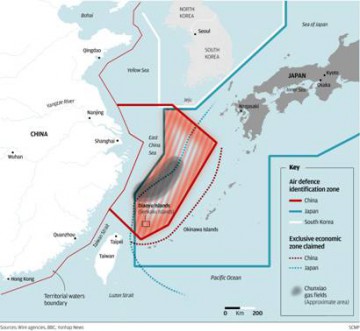21/03/2014
6 - Détournement du Boeing 777 - Pourquoi 8 ingénieurs chinois dans l’avion employés par la Sté Freescale ?
Pourquoi 8 ingénieurs chinois dans l’avion travaillaient pour la Sté Freescale Semiconductor ?
Parce que les US/Sionistes et la Chine travaillent ensemble sur les nouvelles technologies militaires pour rendre les avions invisibles.
Voir les deux articles ci-dessous dont le premier date du 17 décembre 2013 sur le site de Military.com
Avions invisibles : Chine, Etats-Unis pour la dissimulation Race Tech en Anglais :
Invisible Planes: China, US Race for Cloaking Tech

Fox News | |
New stealth technology makes airplanes invisible not only to radar, it renders them hidden to the human eye as well -- just like an invisibility cloak in a Hollywood sci-fi thriller.
News reports from China last week touted the country's work on a "cloaking" technology that uses a hexagonal array of glass-like panels to bend light around an object, obscuring it from view as though hidden by an invisibility cloak. Experts say the technology is legit -- and not unlike American and European projects from the past few years.
"The general public … might not hear about how far the U.S. has really come, because it is and should remain classified," firearms expert Chris Sajnog, a former Navy SEAL, told FoxNews.com. "Other countries are still playing catch-up -- but they're closing the gap."
But while classified work progresses, several public projects from universities and military supply companies show just how real this futuristic technology is.
How to disappear completely
Professor Chen Hongsheng at China's Zhejiang University demonstrated a device that made a fish invisible and a cat disappear, according to the South China Morning Post, a Hong Kong daily.
The professor's team is one of 40 funded by the Chinese government during the last three years, the paper reported. Some projects use materials that shuttle light away from an object; alternatives create electromagnetic fields that bend it away -- truly high-tech camouflage.
"The idea isn't new, but materials enabling the technology are becoming more available," David R. Ricketts, professor of engineering at North Carolina State University, told FoxNews.com. "It's like we see in the movies. If you tape a picture of an empty hallway to a security camera, the person looking at the camera sees an empty room -- even though you could be walking through the hallway. The ‘cloaking' approach simply takes the light on one side of the object and transmits it on the other so that you don't see the object in between."
Another Chinese professor, Ma Yungui, an optical engineer at Zhejiang University, is working on a device that prevents objects from being detected by heat sensors or metal detectors, the Post said. As small as a matchbox, it interferes with infrared camera detection, too -- allowing troops to move secretly in the night.
The Chinese professors did not return calls from FoxNews.com seeking comment.
"A few years ago we had a demonstration of these technologies here in San Diego," Sanjog said in an email. "The mirrors currently being used are large and easily detectable, while the use of wavelengths is limited to a very narrow spectrum, i.e. visible light, but not radar or thermal. Also, both of these technologies only work well when viewed from one angle, and in warfare your security is nothing if it's not 360."
Major arms developers such as BAE Systems readily acknowledge work on this kind of technology, such as the Adaptiv program, which aims to hide armored vehicles.
"The U.S. military is among many who have expressed interest in Adaptiv, which could be transferred to other platforms, such as ships and helicopters," said Mike Sweeney, a spokesman for BAE.
Pixel perfect
BAE's technology, similar to what the Chinese are now touting, deploys sheets of hexagonal "pixels" that can change temperature very rapidly. On-board cameras pick up the scenery and display it on the vehicle, which can allow a moving tank to match its surroundings.
Research is concentrated mainly on the infrared spectrum, a pressing concern for the Swedish government group funding the work. But BAE has combined its pixels with technologies that camouflage other parts of the electro-magnetic spectrum to provide all-round stealth.
But most camouflage used by the military is not as high-tech as these tools. Take for example the "ghilie suit," a garment designed to resemble heavy foliage and popular with the military and hunters.
"As a former lead instructor for the Navy SEAL sniper program, I've taught many of our current warriors the art of passive camouflage. For example, wearing a well-made ghillie suit in the proper environment can render its user virtually invisible, and this is a cloaking device that works 360, with no batteries needed," Sajnog said.
Some experts dispute that these new technologies can work in battlefield conditions at all.
"Invisibility cloak is a poorly chosen term," Thomas Way, associate professor of computing science at Villanova University, wrote to FoxNews.com in an email. "Invisible to what? We already have stealth aircraft that are invisible to radar (usually), but there is absolutely no way given our current understanding of physics that something could be made invisible to the naked eye."
"If that's what they are claiming, it's a hoax."
Related Topics |
http://www.military.com/daily-news/2013/12/17/invisible-planes-china-us-race-for-cloaking-tech.html
République de Chine :
http://www.military.com/topics/peoples-republic-of-china
De même l’Ukraine est un pays important pour la Chine qui y a des intérêts en matières de technologies militaires et d’armement.
Voir l’article ci-dessous :
Crise ukrainienne vue à travers le prisme des intérêts de la Chine
Valentin Vasilescu 19 mars 2014
Crise ukrainienne vue à travers le prisme des intérêts de la Chine
Le projet de résolution du Conseil de sécurité de l’ONU préparé par les Etats-Unis sur le référendum de Crimée a été rejeté par le veto russe.
La Chine, l’un des cinq membres permanents, n’a pas voté comme la Russie, mais s’est abstenue.
La crise ukrainienne a-t-elle créé une fissure dans la relation entre les deux grandes puissances mondiales ? La coopération dans la production de défense entre l’Ukraine et la Chine est forte et durable. Dans les premières années après l’indépendance, l’Ukraine a vendu aux chinois l’un des prototypes de l’avion russe Sukhoi Su-33, version embarquée du Su-27, et les a aidés à le copier sous le nom de J-15. Cet appareil est déjà en service sur le porte-avions chinois Variag (classe Admiral Kuznetsov), acheté à l’Ukraine en 1998. Lors de la conception du nouvel avion de transport lourd Y-20, les Chinois ont à nouveau bénéficié de l’expérience de la célèbre société ukrainienne Antonov. On sait que la marine chinoise a commandé quatre navires d’assaut amphibies aéroglisseurs de classe Zubr, les deux premiers ont déjà été construits en Ukraine et livrés à la Chine. La construction des deux suivants sera effectuée dans les chantiers navals chinois, avec des pièces ukrainiennes, sous la supervision des Ukrainiens. Le navire, qui est le plus grand du monde peut débarquer sur une plage trois chars ou 10 véhicules APC, MLI ou 500 hommes d’infanterie de marine.
Le vote d’abstention sur la Crimée permet une grande marge de manœuvre à la Chine. Tout d’abord, elle s’assure que les Ukrainiens vont continuer à collaborer avec elle, au moins dans le projet de navires de classe Zubr. D’autre part, la Chine ne s’opposerait pas à une éventuelle décision des Etats-Unis et leurs alliés européens d’intervenir militairement en faveur de l’Ukraine, ou d’armer les ukrainiens avec des armes de nouvelle génération, directement ou par des intermédiaires, comme pour les rebelles islamistes syriens. Parce que, avec cela, la Chine a les mains libres pour intervenir militairement partout en Asie du Sud, en citant le précédent Ukrainien.
Le matériel militaire acheté à l’Ukraine est vital pour la Chine, un pays qui, à la fin de cette année sera la première économie mondiale et cherche des prétextes appropriés pour restreindre le statut du leadership militaire des États-Unis dans le Pacifique occidental. Et cela ne peut se faire qu’en brisant le blocus imposé par les États-Unis avec ses alliés dans la région, ce qui permettra la prise de contrôle des routes maritimes qui assure le libre accès de la Chine dans les océans Indien et Pacifique. La principale orientation stratégique pour assurer l’accès de la Chine à l’océan Pacifique est le contrôle des voies maritimes définies dans l’espace situé entre l’archipel japonais d’Okinawa (Ryukyu) et Taiwan. L’archipel Senkaku, situé entre l’île de Miyako et Taiwan, se compose de huit îlots appartenant au Japon, réclamés ces derniers temps, de manière plus agressive par la Chine. Les Chinois ont étendu leur zone d’action dans la mer de Chine orientale entre le Japon et Taïwan sur les îles Senkaku (appartenant aux Japonais) en créant une zone de surveillance maritime et aérienne à l’aide de 78 drones de moyenne et haute altitude.
Avec l’archipel de Senkaku, entre également dans les visées de la Chine l’Ile de Taïwan, allié clé des États-Unis dans la région qui est habitée par une population chinoise et qui appartenait à la Chine jusqu’à la Seconde Guerre mondiale.
Par Valentin Vasilescu, pilote d’aviation, ancien commandant adjoint des forces militaires à l’Aéroport Otopeni, diplômé en sciences militaires à l’Académie des études militaires à Bucarest 1992
Traduction Avic
http://reseauinternational.net/crise-ukrainienne-vue-travers-prisme-interets-chine/
20:47 Publié dans Actualité, politique ou géopolitique, Economie, Arnaques, Mensonges, Propagande, Conspiration mondiale, Conspiration, Complot, Corruption, Crimes contre l'humanité, Eugénisme, Espace, Laniakea, Grand Attracteur, France/Israël/Elections, Les Illuminati-Reptiliens, ONU, OTAN, Poutine, Russie, Crimée, Ukraine, Chine, BRICS; Sy, Rothschild, Mafia Kazhar, Sionisme, Oligarchie, LDJ, USA, Israël | Lien permanent |  |
|  del.icio.us |
del.icio.us |  |
|  Imprimer |
Imprimer |  Digg |
Digg | ![]() Facebook | | |
Facebook | | |  |
|







Les commentaires sont fermés.